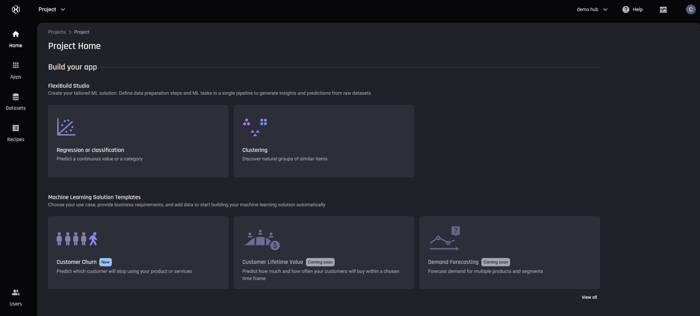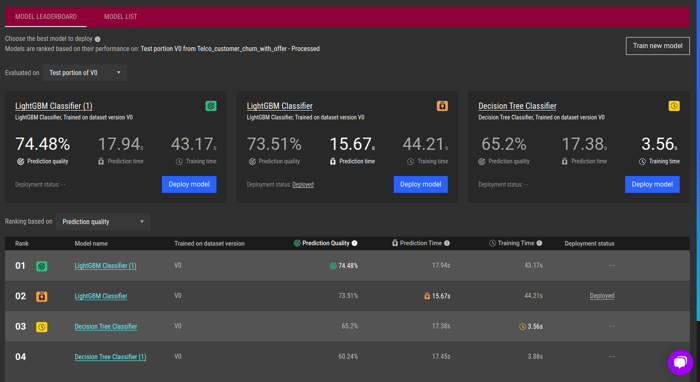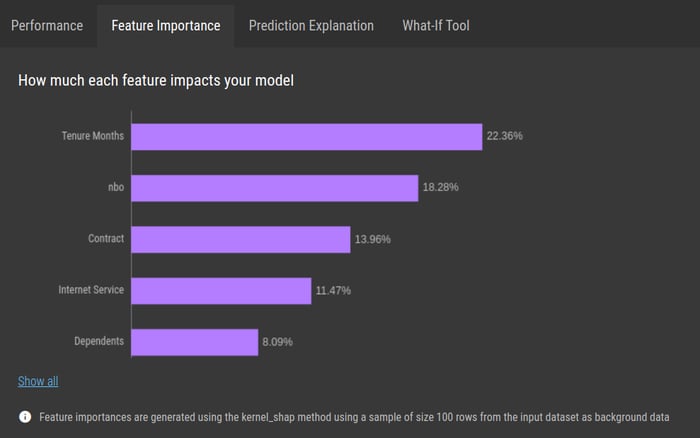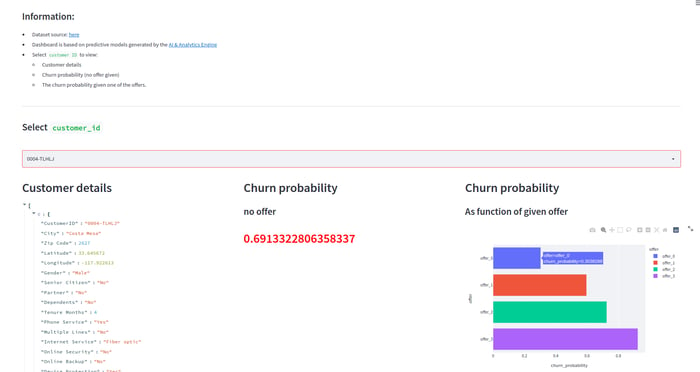Overview
Customer churn, defined as the percentage of customers who stop paying for a product or service in a given time period, is a pervasive issue throughout any business, directly impacting profitability. This is particularly evident in the telecommunications industry where the cost of acquiring a new customer is 5-10 times greater than retaining an existing one.
The telecommunications industry has become increasingly competitive, and as a result, most churn cases occur when a customer deliberately transitions to a competing company. Using machine learning (ML) companies can efficiently identify customers that are likely to churn providing the opportunity to target the right customer at the right time with retention strategies. In addition, ML can be applied as part of a retention tactic to provide insight on the next best offer to retain the customer.
Historically, it has been hard for companies to develop and implement ML solutions for churn, due to the investment in both time and resources required. The AI & Analytics Engine (The Engine) overcomes these barriers by providing an easy-to-use, end-to-end ML capability- so existing teams can develop and operate ML-powered churn solutions.
Current Challenges in Telco
The increased competitiveness in the telecommunications industry has resulted in an average churn rate between 20-40% annually. The combination of more informed customers with lower switching barriers between competitors has resulted in a decline in brand loyalty. Increasingly, customer experience is fundamental to making a purchase decision. Factors including network-related experience, price value perception, and customer service are contributing factors to customer churn. Identifying the likelihood of a customer churning and implementing a preventative measure is a pivotal problem to solve for telecommunications companies' ongoing business success.
The traditional method of identifying customer churn is through manual analysis and rule-based systems. While any method of churn identification is better than none, traditional methods are costly in terms of resources, often requiring a team of data scientists or analysts, and can be extremely time-consuming with large, complex datasets. Finally, the accuracy can be underwhelming, often overlooking customers who churn and generate false positives.
Customer Churn Prediction with Machine Learning
Machine learning enables the creation of models to predict the likelihood of churn for customers. These models make it possible to analyze large and complex datasets.
Leveraging ML techniques helps telco providers better understand and manage their customers. This enables companies to make data-driven strategic decisions, minimizing churn and maximizing profitability. Identifying customers with a high probability of churn, allows the company to intervene early, and prioritize retention strategies, such as providing the next best offer (NBO).
In addition, understanding the underlying factors that contribute to churn allows a company to optimize its communication and products, improving the overall customer experience.
Solving Customer Churn with the AI & Analytics Engine
The AI & Analytics Engine easily and without heavy investment, provides ML capability to predict customer churn and the next best offer solutions. The Engine does not require heavy pre-requisite data science or coding skills to effectively operate.
This use case demonstrates how to efficiently use telco customer data to build and understand both customer churn and a next best offer retention strategy.
The Customer Churn Prediction Template
The AI & Analytics Engine includes a purpose made customer churn prediction template solution, using transactional data and customer information, designed to make getting actionable results a seamless process. For this use case, we will be using FlexiBuild Studio to demonstrate the full utility of the Engine.

Data
The dataset consists of 7000 customer records with basic information about demographics (gender, age, partner etc.), location (city, zip code etc.), service (tenure, subscribed services, payment method etc), whether or not they churned in the last quarter (churn column), and what past offer they may have been offered.

The Machine Learning Process
The data can be uploaded to the platform, or the Engine can connect to the company database and fetch the required customer data from it. Then, the dataset can be processed further with the Engine’s data wrangling tool if necessary.
Next, taking the prepared dataset a binary classification app is created, the target variable is “churn”, this is the column that the model will learn to predict.
The Engine provides a list of predictive models ranked by their estimated performance metrics, allowing the user to select the ones that is best suited to the the business requirements, saving time and resources training models that wouldn’t yield the desired performance. From here, the selected model/s are trained and are shown on the leader board, enabling easy comparison of their performance metrics.

Customer Churn Predictions
The predictions made by the selected model can be consumed in two ways;
Batch Prediction
Batch prediction involves uploading a file containing unlabeled customer data to be predicted in the same schema as the dataset the model was trained on. This generates an output file which is the original one plus two additional columns: The probability of churn in the next quarter and a label stating whether the customer is predicted to churn or not (probability > 50%).
API
After deploying a model, one can send an API call to the model endpoint, containing a row of customer data. The API endpoint lets companies route their prediction where it makes most sense to consume, and from here they’ll get back the likelihood of churn in the next quarter.
Understanding The Models Predictions
The Engine supports explainable AI, which means it has various features that help the user get a better grasp of the factors that contributed to the predictions. One of these is the “feature importance” tool, which ranks the features of the prepared dataset that impacted the customer's propensity to churn prediction.
This insight would help telco companies understand which features contribute the most to the likelihood of churning and allow them to proactively implement retention strategies. In this case, the feature that most impacts the churn prediction most are tenure in months. Next is the “next best offer”, followed by type of contract.

Next Best Offer Model
Subsequent to churn identification is developing a retention strategy. Offering a different, possibly more enticing product, is one of many tactical approaches. This is made possible by predicting the risk of future churning for customers, given their features and as a function of a particular product offer given.
This way, for each client regardless of the offer they historically received, a prediction can be made of the probability of churning if they were to receive a specific product offer. The “next best offer” tactic, allows businesses to optimize the ROI for customers, by comparing the churn probability to the profit for different products that they can offer a customer.
Integrating The Solution
Trained models can be deployed and called by an external dashboard as part of the Engine's API and SDK access. Within the example dashboard, it is evident that for each customer there is:
-
A churn probability if they were to receive no additional offer;
-
A churn probability if there were to be offered a specific product, denoted as offer_1, offer_2 etc.

Benefits of Using the AI & Analytics Engine for Churn Prediction
Benefits of using the engine for churn prediction in comparison to traditional churn analysis include;
-
Handles large volumes of complex data.
-
Can easily update models with new data.
-
Fast, affordable and gives ML capabilities to analysts.
-
Explainable insight into the underlying factors affecting churn.
-
Enables cost benefit analysis for different products through comparison of churn probabilities
Industry Application
Gaining insights into customer behaviour is valuable for any business across all industries, and being able to tailor services based on ML predictions improves the customer experience. Customer churn is inevitable and occurs in all industries, for example in the retail banking industry with a rate of 25% annually, and manufacturing with 33%. Predicting churn and implementing retention strategies is one of the most effective ways of increasing profit no matter the business.